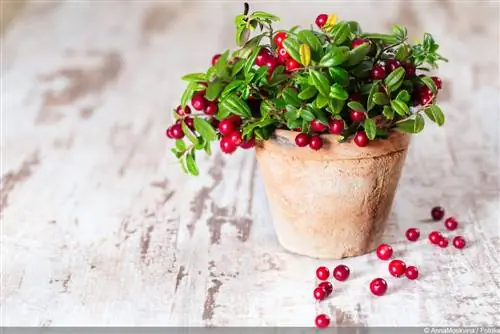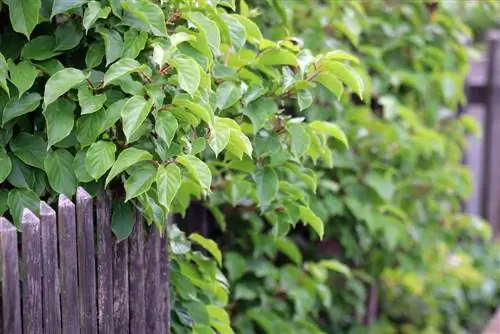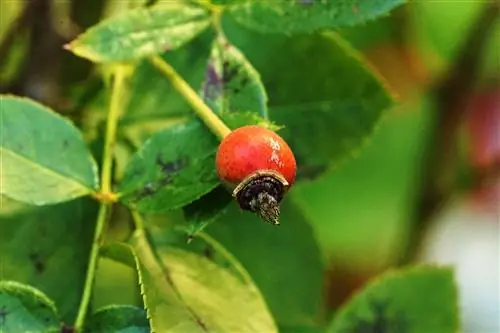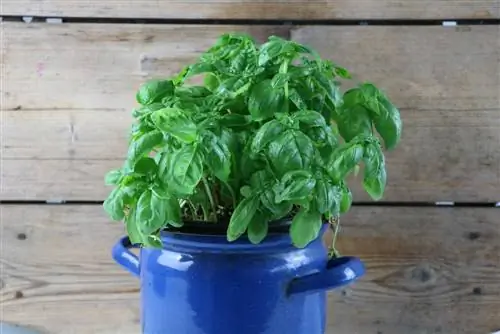- Author admin [email protected].
- Public 2023-12-17 03:39.
- Last modified 2025-06-01 06:48.
With Thymus vulgaris, experienced hobby gardeners round off their functioning plant community in the kitchen and ornamental garden. The Mediterranean herb plant knows how to impress as an aromatic kitchen ingredient as well as a wonderfully flowering perennial. The decision to cultivate classic thyme is particularly easy given the uncomplicated requirements for location, plants and care. Stop puzzling over the detailed aspects of a successful cultivation protocol. All the important details are explained below - understandable, precise and practical.
Profile
- Plant family of the mint family (Lamiaceae)
- scientific name: Thymus vulgaris
- Mediterranean subshrub
- Growth height 10 cm to 40 cm
- green lanceolate to oval leaves with a spicy aroma
- Flowers in white, pink to purple from June to October
- hardy down to -15 °C and evergreen
- popular names real thyme, garden thyme, spiced thyme
Thymus vulgaris scores with a variety of other useful attributes. The plant is considered a popular pasture for bees, drives away ants and develops such intensive healing properties that it was named medicinal plant of the year in 2006.
Location
The Mediterranean origin leaves no doubt. Thymus vulgaris thrives in sunny locations. This applies to the bed as well as the balcony and the windowsill. The warmer the temperatures, the more extensive the need for light becomes. This means that when cultivating in the house, the only option that should be considered is a window sill on the south side of the house. Otherwise, the shoots will turn brown within a short time because the plant is looking for sunlight.
Tip:
Sun-drenched dry stone walls and Mediterranean rock gardens offer promising locations for lush growth. Here the heat is stored in the stones during the day and released over the course of the night, which is very beneficial to the aroma content in Thymus vulgaris.
Soil and substrate
With regard to the nature of the soil, real thyme does not require any specific effort. The following properties are advantageous:
- normal garden soil with a slightly sandy consistency
- loose and well drained, without risk of waterlogging
- preferably calcareous and lean with a pH value of 7-8
- Commercial herb soil is suitable in the pot
Consequently, the upper area of the herb spiral can be used as a planting site, also called the dry zone.
propagation by sowing
If you don't want to use young plants grown by someone else to grow Thymus vulgaris, use the quiet winter time to sow behind glass. The perfect time window for cultivation opens in mid/late February. A pot or seed tray is filled with nutrient-poor substrate, such as peat sand, coconut fiber or perlite. Then sprinkle the fine seeds on top. As light germinators, they are sieved with a maximum of 0.5 cm of sand or fine-crumbly substrate. The sowing is preferably moistened with a hand sprayer. At a germination temperature of 20 to 22 °C, germination begins within 10 to 14 days. Then place the seed container a little cooler at 15 to 18 °C. Instead of pricking out, sort out the weakest specimens. This caution significantly reduces the stress on the seedlings.
Plants in the bed
The thyme plants you have grown yourself or purchased can be planted all year round as long as the ground is not frozen. The second half of May is considered the perfect planting time. Here's how to plant step-by-step:
- Place the root ball in water and let it soak for 20 minutes.
- Weed the clod thoroughly and loosen it at the intended location.
- The planting hole is at least twice as large as the root ball.
- Mix the excavated material with compost and horn meal as starting fertilizer.
- Unpot the young plant, plant it and water it.
The upper edge of the thymus vulgaris is flush with the surface of the earth. Finally, a 'dry collar' is recommended. This is a thin layer of mulch made of gravel or grit that protects the surrounding soil from erosion.
Plants in pots
A purchased thyme plant is, if possible, transplanted into a sufficiently large pot on the same day. Only use a container with a bottom opening as a water drain. Spread a drainage system over it, consisting of coarse, inorganic materials such as pebbles or crushed shards of pottery. Now fill in the substrate by a third. This is followed by the young plant, which was previously able to soak up water. As you pour in the remaining herb soil, press it with your fist so that no cavities form. A small pouring rim always makes sense.
Tip:
To improve the permeability of the substrate, add a handful of perlite, expanded clay or sand.
Care
Proper care of Thymus vulgaris is limited to the following factors:
- Do not let it dry out during the growing phase.
- Water well-established thyme only when it is dry in summer.
- Never water under the blazing sun, but in the early morning.
- In container culture there is a regular water requirement.
- The substrate should dry between waterings.
An optimal nutrient supply for real thyme consists of adding mature compost twice, each in spring and late summer. Treat spiced thyme in the pot with a commercially available liquid fertilizer every 4 to 6 weeks. All application of nutrients ends in August at the latest so that the plant can mature before winter.
Cutting
A subshrub only develops vitally and he althily if it receives regular pruning. Thymus vulgaris is no exception in this regard. Only then can baldness be effectively prevented, while at the same time promoting the desired bushy growth habit. This care measure applies regardless of a harvest, which experience shows occurs sporadically when the kitchen calls for the spice.
- Shrink garden thyme according to a fixed schedule right from the start.
- Leave at least a 5 cm high, non-woody piece of greenery on the bush.
- Cut dry and suffering-looking branches at the base.
A radical rejuvenation cut every 2 to 3 years makes an important contribution to maintaining plant he alth. Late summer or fall is the best time to carry out this important care measure. A Thymus vulgaris is completely cut off to a hand's breadth above the ground.
Wintering
Real thyme bravely withstands the local winters, no matter how frosty they may be. Since there is a risk of the root ball freezing in the pot, a cover made of bubble wrap serves as insulating protection. However, the branches are not wrapped because moisture could develop, which leads to mold and rot. Drought is probably the biggest threat during the winter, especially when there is no snow. In this case, water the evergreen thyme on frost-free days.
Harvest
The evergreen, hardy herb delivers its aromatic harvest all year round. In premium quality, cut Thymus vulgaris during flowering, which extends from June to October. Ideally, you should always cut the entire shoot up to 5 cm above the ground. During the winter time it is advisable to harvest up to 10 cm high.
What you should know about thyme in brief
Thymus vulgaris impresses with a broad spectrum of beneficial attributes. First and foremost, the mint family provides one of the most important culinary herbs for countless dishes. In addition, the dreamlike flowers have what it takes to become a dominant ornamental perennial. Not to mention its recognized healing properties for various he alth problems. Real thyme develops this extensive potential on the basis of undemanding care, uncomplicated planting and low location requirements.
- Species/Family: Herbaceous Plant
- Care effort: Low because it is frugal
- Flowering time: June to July with a multitude of small light purple to pink or white lipped flowers densely arranged in whorls
- Foliage: Very small, aromatically scented, elliptical and leathery leaves in different shades of green depending on the variety
- Growth: Cushion-like growth even in the smallest cracks; Ground cover that forms dense carpets with creeping and long shoots
- Height: 5 to 40 cm
- Location: Sunny and warm; sandy soil, rather nutrient-poor and dry
- Planting time: Can be grown as seeds from March to May in a cold frame or sown directly outdoors, germination time 30-45 days at 20-26 °C
- Pruning: Cut back in autumn or spring, but not more than a hand's breadth above the ground
- Partner: Different varieties that grow together in larger areas are very beautiful
- Propagation: Cut soft cuttings in summer or divide larger, older plants in spring or fall
- Care: Water only when dry conditions persist. Do not fertilize. Regular pruning maintains growth vigor
- Wintering: Is grateful for winter protection in frosts without snow (bare frosts) and winter wetness, as roots rot quickly; Often cannot survive the winter in the wrong location
Special features
- also called real thyme
- is primarily native to the Mediterranean region
- fits well in the rock garden or in the gaps in a dry stone wall
- Snails don't like the smell and reliably stay away from the plants and branches
- can also be cultivated in a pot
Thyme species
- Carpet thyme: Also called cushion thyme or sand thyme. Height 5-10cm. Forms very dense carpets. Can also serve as a lawn replacement
- Lemon thyme (Thymus x citriodorus): Cross between real and field thyme; small, narrow silvery-white, yellow-green or dark green, white-edged leaves that smell like lemon; forms rather small, rounded cushions. Likes nutrient-rich soil
Thyme varieties (selection)
- `Albus: Carpet thyme. Light green leaves with matching delicate pink flowers
- `Coccineus: Carpet thyme. Dark variety with pink-red flowers on strong dark green foliage
- `E. B. Anderson: Lemon thyme. Yellow-green variegated foliage
- `Golden Dwarf: Lemon thyme. Robust variety. Light green leaves with slightly yellow markings
- `Silver King: Lemon thyme. Stands out for its silvery-white variegated leaves. Exudes very intense lemon scent
- `Splendens: Carpet thyme. Stands out with its bright pink flowers
Usage
- Medicine: Thyme extract (often associated with real cowslip - Primula veris) is used in some combination medicines, especially for respiratory diseases
- Medicine/Wellness: Thyme extract in the bath additive has a very invigorating effect and helps with physical exhaustion. It promotes blood circulation in the skin and inhibits inflammation of the respiratory tract. Because of its stimulating effect, a full bath with thyme extract should not be taken directly before going to bed
- Kitchen: Can be used both fresh and dried. To dry, simply tie several stems together and hang them upside down in a dry place. However, it should be noted that dried thyme has a more intense aroma than fresh thyme. Here, about half the amount of fresh cabbage is enough






